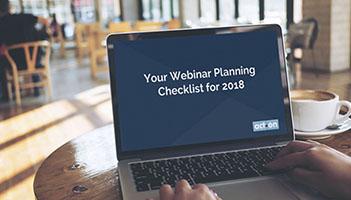Webinars are a proven lead generation tactic that can fill your pipeline. So, why do most suck? Below are 10 tips to add to your webinar planning checklist.
Perhaps this is true for you, too, but I have signed up for a ton of webinars over the years. More than half of them, I bet, I have tuned out or clicked shut within the first few minutes. Why? A few of the big reasons most webinars fail are:
- They were all sales and no value add
- They promised something specific and gave me something general (or vice versa)
- The presenters were not prepared, resulting in technical issues that could have been figured out, or using too many umms and ahhs and other filler words
To have a successful webinar, you should know who should attend, and then deliver information that they want. It’s nice if you can be entertaining along the way, but what’s really important is to deliver value – information people want and need woven into your webinar content. Do that, and they’ll stick with you and perhaps take that next step with you.
Your Webinar Planning Checklist:
1. Decide what story your presentation will tell. Make an outline or use a diagram to clarify for yourself the one main idea, key supporting points, and validation or proof points. Bear in mind that people don’t watch webinars to buy something, but to learn something. Fulfill that expectation.
2. A very general webinar will draw a more top-of-funnel audience. The tighter the focus of your webinar, the likelier attendees are to be looking for a solution to a specific problem and a bit further along the buyer’s journey. Know which camp your audience will fall into and tailor your materials for them.
3. Don’t overwhelm slides with too much text; make sure to leave plenty of white space.
4. Have lots of images. Remember that showing is better (and more lasting) than telling. And a picture is still worth (at least!) a thousand words.
5. Tell stories. A dry, pedantic presentation will put people to sleep; stories and examples help people identify with the situation. And if they can see themselves in a story, they might perhaps see how your approach to solving a problem can benefit them.
6. Make slide titles serve as headlines or subheaders. If later you post your slide deck without narration (on SlideShare or your own website), the titles will need to help the reader through the presentation.
7. Add speaker notes to your slides. They help keep you on track and ensure that you cover all the points you want to make. Be sure to print out your webinar slides with speaker notes and have them handy as you deliver the webinar content, so you’re covered if the technology fails. You can also make notes on it during your presentation and the Q&A session.
8. Make the introduction SHORT. Get short biographies from your speakers well ahead of the webinar and have a concise, powerful message for each one. Don’t start off by telling all about your company and what it does. Get right into what people came for, or you risk losing them before you even begin.
9. At the end of the webinar, include a Q&A and have a closing slide that offers contact information. 92% of webinar attendees want a live question and answer session at the end of a webinar. In closing, be sure to cover next steps for the audience to take, thank the presenters for their time, and thank the attendees as well. Good manners go a long way in making your brand memorable.
10. Make sure the contact information includes varied methods, such as an email address, URL, phone number, social icons, or other ways people can take the initiative to get in touch or learn more on their own.
After the Webinar
What you do after the webinar is over is just as important as the webinar itself. Have a plan. Most plans will include sending a recording and the slides. If you are using marketing technology, such as an Adaptive Marketing Platform, attendee info will be entered into your CRM as a lead; or if they are already a lead, their webinar attendance will be added to their lead scores.
The next thing I strongly recommend is to consider how you can repurpose the webinar. Pass along the recording to your in-house video editor to polish into an on-demand webinar. In addition to the 45-60 minute version, I will also edit the webinar down to a 15-minute on-demand webinar. I may also create a 1-minute version that is ungated and is used for getting folks to check out the 15- or 60-minute versions (see the video below).
Let me know what tips you have for holding a successful webinar, as well as any post-webinar strategies you’ve seen work. We may include them in a future post or podcast (or webinar).
